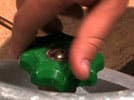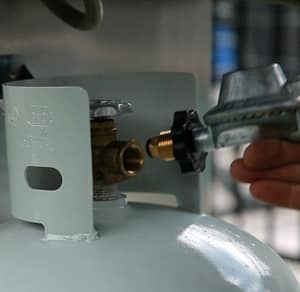How to Turn a Gas Bottle On & Off
How to Turn Off Gas Cylinder:
 Rotate the hand wheel, on top of the cylinder, clockwise
Rotate the hand wheel, on top of the cylinder, clockwise- Close by hand only until firmly closed
- Do not use tools or overtighten
- If you have more than one gas cylinder, be sure to turn both off (as with 45kg cylinders)
- For BBQs, turn off all of the burners AFTER you close the gas bottle valve
How to Turn On Gas Cylinder:
 Rotate the hand wheel anti-clockwise (counter clockwise)
Rotate the hand wheel anti-clockwise (counter clockwise)- Only open about two turns
- Do not open hard to the stop
NOTE: This advice applies to POL & LCC27 valves used in Australia. Procedure may be different for other valves in other countries.
Why You Should Turn Off at the Gas Bottle First
In a perfectly engineered world, everything on your BBQ would seal perfectly.
The reality is that gas burner valves and regulator connections can leak.
This is especially true as they wear with age and there can be quite a few valves on a single BBQ.
For example, with a six burner BBQ, there are at least 7 gas seals that must be perfectly seated to avoid leaks.
The leaks can be very small and unnoticeable.
However, over time, a substantial amount of gas could leak out of your BBQ if you do not close the gas bottle valve.
This is why it is a good habit to turn your BBQ off at the gas bottle first.
Why It Is Safer
How You Save Money
How to Turn a Gas Bottle Off Safely – How to Turn Off Gas Cylinder
The best practice is to turn off the gas bottle first, when you turn off your BBQ.
This eliminates the possibility of leaks from all of the burners and the regulator connection while in storage.
It also uses up all of the gas remaining in the gas lines so you are safely storing your BBQ with no remnant gas remaining in the unit.
- Turn your BBQ off at the gas bottle first by turning the valve clockwise
- Close firmly by hand only
- Turn off all of the burners
- Store BBQ in a well-ventilated outdoor location
Hot To Safely Attach or Change Your BBQ Gas Bottle
Connecting & Disconnecting:
 The male connector of a POL regulator has a reverse or left-handed thread.
The male connector of a POL regulator has a reverse or left-handed thread.
So, to detach, you turn a POL valve clockwise and then anti-clockwise to re-attach.
New Type 27 (LCC27) connections have a right hand thread.
So, for the new LCC27 valves you turn it anti-clockwise and then clockwise to re-attach.
For full step-by-step instructions, please see:
How to Attach or Change Your BBQ Gas Bottle
BBQ Gas Leak Test
Common Problem Areas
Main Connection:
 The old standard BBQ regulator in Australia is a POL regulator.
The old standard BBQ regulator in Australia is a POL regulator.
The new standard BBQ regulator is a LCC27 BBQ regulator.
The male connector of the regulator, which screws into the POL gas valve on your gas bottle, may have a rubber O-ring seal or it may rely on a metal to metal contact seal.
You should always inspect the regulator for damage, paying special attention to the connector, which screws into the gas bottle.
If it has a rubber O-ring, it also needs to be undamaged.
Gas Hose
 The gas hose is attached to the regulator on one end and the BBQ on the other end.
The gas hose is attached to the regulator on one end and the BBQ on the other end.Valve Stem
In Australia, BBQ gas bottles must be tested every ten years.
The gas valve is changed upon inspection and the valves are expected to last for the full ten years.
However, occasionally the valve will fail prematurely and start leaking from around the valve stem.
This is rare but it can happen.
Please see Gas Bottle-Cylinder Testing Facts for more information on the ten year testing process.
Bleed Screw
The bleed screw is a small slotted screw on the side of the valve that lets gas vapour bleed off during the decanting refill process.
The refill technician opens it during the filling process and closes it, when done.
The screw can develop a slow leak if it becomes loose.
How To Do The Leak Test
This short video (1:00) shows how to do the soapy water leak test
When to Test
Soapy Water Solution
You will need a soapy water solution to check for any leaks.
Mixing liquid hand soap with water should work fine. Place the solution in a liquid spray bottle.
It’s a good idea to leave the spray bottle with the BBQ, so it’s always a handy reminder to perform the leak test.
No Ammonia
How to do the Soapy Water Test
Put some soapy water in a spray bottle or a dish.
Turn on the gas bottle without turning on the BBQ. This pressurises the system.
Next, spray the entire valve, regulator and hose assembly with the soapy water.
Alternatively, you can apply the soapy water with a paint brush, basting brush or it can even be sponged on.
Bubbles will form if there is a gas leak and you may also smell the gas.
Extra Safety Tip
 The best practice gas safety advice is that gas bottles should only be in a vehicle for the minimum required transport time.
The best practice gas safety advice is that gas bottles should only be in a vehicle for the minimum required transport time.
When you do transport a gas bottle, you should consider one added precaution.
After making sure that the valve is firmly closed, you should spray the entire valve assembly to check for any possible leaks, prior to transport.
DO NOT leave BBQ bottles in enclose vehicle unnecessarily.
New Residential LPG customer?
New Business LPG customer?
Existing ELGAS customer?
- BBQ – Gas and Charcoal BBQ Features – Charcoal BBQ vs Gas BBQ Comparison - March 31, 2025
- GPL Gas (GPL Fuel) – GLP Gas – LPG Gasul: GLP-GPL Gas Station - March 26, 2025
- Think LPG When Building a New Home - February 26, 2025
Steve Reynolds
Technical Consultant
Steve Reynolds is a leading expert in the LPG industry with over 22 years of experience. As part of the national management team at ELGAS, Steve ensures the safe and efficient storage, handling, and transportation of LPG. He serves as the lead investigator for incidents and collaborates with authorities on industry developments.
Steve is a technical advisor to Standards Australia and Gas Energy Australia (GEA), and an active member of the World LPG Association (WLPGA), contributing to global standards and technical reviews. He holds a BSc. (Hons) in Industrial Chemistry from UNSW and has held senior safety and technical roles at ELGAS, making him a trusted authority in LPG safety and standards.





